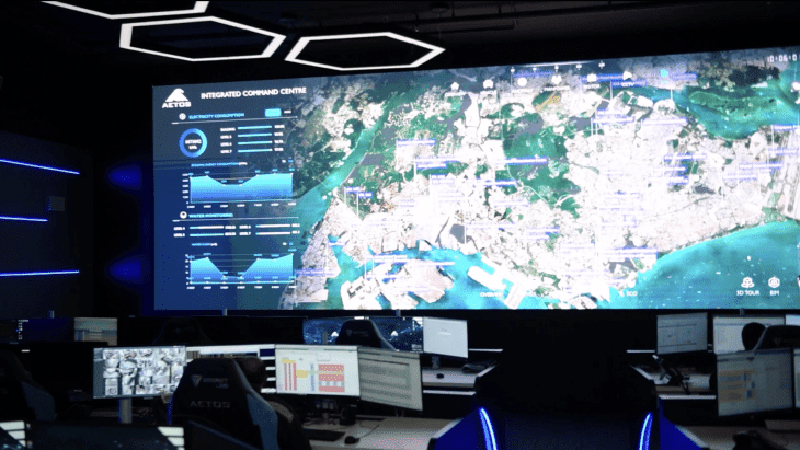It brings together operational silos to offer 24/7 unified remote monitoring capabilities.
Within the purpose-built AETOS Headquarters at 5 Corporation Drive in Singapore is a 260-square-metre room with hexagonal-shaped ceiling lights and a 12-metre wide LED screen in the centre of the room. This unassuming space is the AETOS Integrated Command Centre (ICC)—the nerve centre of island-wide operations which houses 13 security operators.
Considering the amount of technology within the room, the ICC offers so much more for the clients of security firm AETOS. Implementing Singapore’s largest 3D digital twin, the ICC is an agnostic platform that ingests data from unlimited subsystems from multiple premises and beyond borders.
“Technology was at a point where we could harness best-in-class partnerships, and bring them all together into one setup, which we call the Integrated Command Centre. Our ICC unifies what used to be silo operations to catalyse value for our stakeholders,” said AETOS CEO Alfred Fox during an interview with Singapore Business Review.
It took over more than a year for AETOS to build the ICC. It was launched in March 2022.
Comfortable operator chairs
To ensure that the AETOS staff remain vigilant and motivated whilst being well-trained, Alfred said they make the command centre a comfortable working environment for its operators by providing gaming chairs.
“Our concept was if a gamer can sit on a chair for hours, such chairs will provide good support for our people as well—and they like it,” said Alfred.
The 36 chairs, customised in collaboration with Singapore-based company, Secretlab, were installed in the new ICC to give better lumbar support for command centre operators of varying heights, weights, and body types.
Three-dimensional digital twin
One of the main components of the command centre is the 3D digital twin model, which replicates a physical location. This capability elevated their services to clients by being able to remotely monitor the security, safety, and facilities management of multiple locations.
The ICC gathers the integrated data from multiple subsystems, analyses it, and then visualises real-time operations in digital twin—an immersive virtual replica of the location.
“In the past, people used to visualise operations through maps and two-dimensional drawings. When we discovered that this could be visualised on a digital twin, it changed the game for us and for the industry,” added Alfred.
An example, for elderly living in their own homes, upon a “fall detection”, the command centre operator can view and verify the incident in real-time via the 3D digital twin, before deploying the nearest AETOS’ mobile forces to respond to these senior citizens.
“Whilst it is not quite related to security in the traditional way, it assures that you are safe, taken care of, and empowers ageing-in-place, in your own home,” said Alfred.
The full scale of operations in the digital twin environment can be viewed on the centre LED video wall, which is about three metres high and 12 metres wide.
Reduced manpower
Since digital twin technology creates a three-dimensional model of a house or hospital, it allows the staff at the command centre to remotely monitor the security of a specific site using video analytics.
This can reduce the number of night guards at the premises as it could be similarly safeguarded via regular virtual patrols. Meaning, there is no need to send someone to physically assess the situation. Through the digital twin, operators can access the CCTV cameras for verification purposes.
“Through the ICC, you can determine if there is a level two incident already because it will show an alert on your digital twin. You can then zoom in to the closest CCTV to assess the situation and determine if it is a false alarm, or perhaps someone is attempting to break in. This is what we call virtual patrol,” Alfred explained.
Carbon tracking
Beyond security, safety, and facilities management, the AETOS ICC can also track the carbon footprint of its own buildings and of its clients as well.
“Through the data collected from air quality sensors, electricity, and water, you can now unlock better insights into how much you’re using and can possibly optimise within the building,” Alfred said.
Embarking on data-driven operations also makes a building “smart” and enables building owners to leverage technology to shift from reactive to predictive, such as AI-based workflows which can automatically adjust usage levels, send alert notifications or schedule deployment; helping to optimise manpower, increase operational efficiencies and cut costs.
“Now, we can have Internet of Things sensors deployed everywhere which can track these emissions, almost in real-time,” said Alfred. “Through such monitoring and analytics, we can also help our clients make progress in achieving their sustainability goals.”
Liked this post? Follow SwirlingOverCoffee on Facebook, YouTube, and Instagram.


